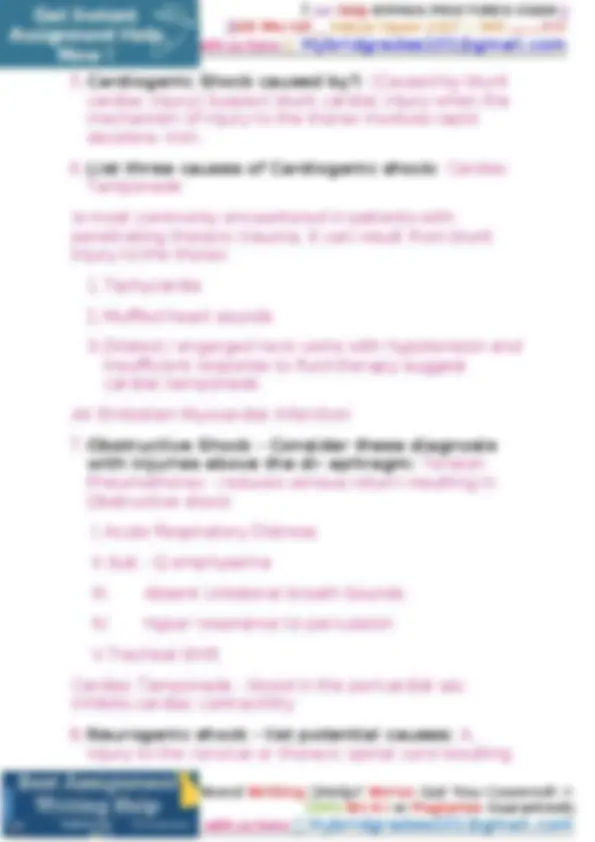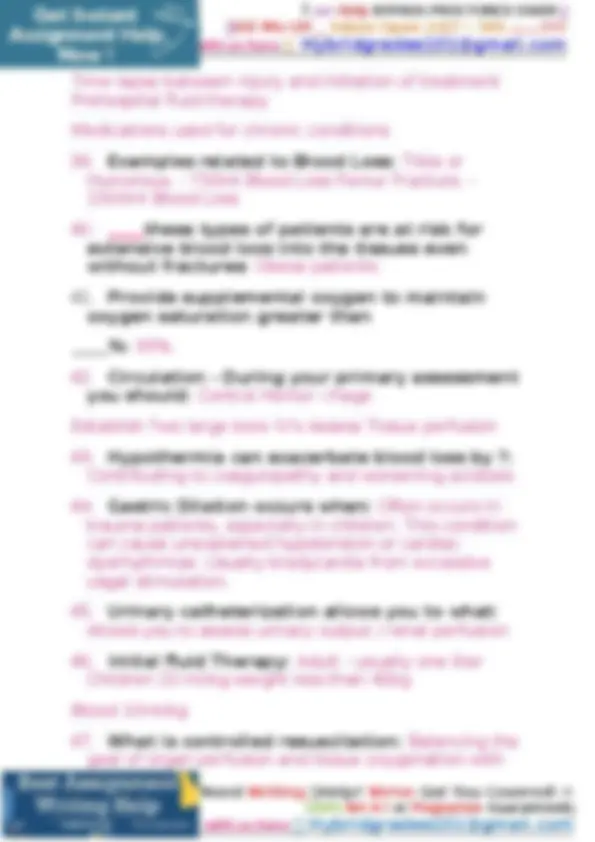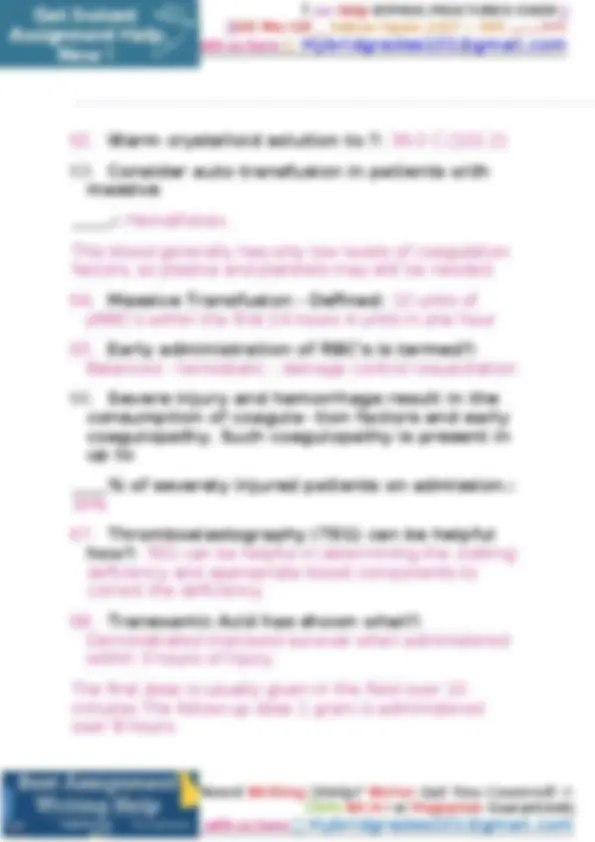Download ATCN Advanced Trauma Care for Nurses: Shock Management Review Questions and Answers and more Exams Traumatology in PDF only on Docsity!
STN Society of Trauma
Nurses
ATCN Advanced Trauma Care for Nurses
ATCN Knowledge-Based Exam &
Trauma Simulation Assessment
Course Title and Number: ATCN Advanced Trauma Assessment Exam Title: ATCN Exam Exam Date: Exam 2025- 2026 Instructor: ____ [Insert Instructor’s Name] _______ Student Name: ___ [Insert Student’s Name] _____ Student ID: ____ [Insert Student ID] _____________
Examination
Time: - ____ Hours: ___ Minutes
Instructions:
- Read each question carefully.
- Answer all questions.
- Use the provided answer sheet to mark your responses.
- Ensure all answers are final before submitting the exam.
- Please answer each question below and click Submit when you have completed the Exam.
- This test has a time limit, The test will save and submit automatically when the time expires
- This is Exam which will assess your knowledge on the course Learning Resources.
Good Luck……...!
📱Hit Me UP__ Inbox Open 24/7 – 365 …...!!!! 📱 Chat with us here : 📱 Hybridgrades101@gmail.com
ATCN Module 4 Chapter 3 Shock ATCN
Advanced Trauma Care for Nurses Module
Review Questions and Answers | 100% Pass
Guaranteed | Graded A+ |
ATCN Knowledge-Based Exam & Trauma
Simulation Assessment
ATCN Advanced Trauma Care for Nurses
Exam
Read All Instructions Carefully and Answer All the Questions Correctly Good Luck: - 1.What is the first step in managing shock in trauma patients?: The first step in managing shock in trauma patients is to recognize it. 2.Define Shock: An abnormality of the circulatory system that results in inadequate oxygen perfusion and tissue oxygenation. 3.List the second step in managing shock: Is to identify the probable cause of shock and adjust treatment accordingly. 4.List the four type of shock?: Cardiogenic Shock Obstructive Shock Neurogenic Shock Septic shock Need Writing 📱Help? We've Got You Covered! ✍ 100% NO A I or Plagiarism Guaranteed📱 Click Here To <> Follow Link
https://yourassignmenthandlers.kit.com/93b2309b
!!!.ORDER NOW.!!! << TO GET INSTANT EXPERT HELP >> !!!.ORDER
NOW.!!!
📱Hit Me UP__ Inbox Open 24/7 – 365 …...!!!! 📱 Chat with us here : 📱 Hybridgrades101@gmail.com in loss of sympathetic tone and subsequent vasodilation B. Isolated intracranial injuries do not cause shock, unless the brain stem is required C. The classic presentation of neurogenic shock is hypotension without tachycardia or cutaneous vasoconstriction. D. The failure of fluid resuscitation to restore organ perfusion and tissue oxygenation suggests either continuing hemorrhage or neurogenic shock 9.Septic Shock - Define: Patients with early septic shock can have normal circu- lation volume, modest tachycardia, warm skin, near normal systolic blood pressure, and wide pulse pressure.
- In which group of patients, may be the underlying reason or precipitating cause of traumatic injury be be an unrecognized infection, commonly a urinary tract infection.: In Elderly, the underlying reason or precipitating cause of traumatic injury be be an unrecognized infection, commonly a urinary tract infection.
- is the most common cause of shock in trauma patients: Hemorrhage
- Cardiac Output is comprised of what two things?: Cardiac Output = Heart rate x stroke volume
- Stroke Volume is classically determined by:: Preload, myocardial contractility, and afterload Need Writing 📱Help? We've Got You Covered! ✍ 100% NO A I or Plagiarism Guaranteed📱
📱Hit Me UP__ Inbox Open 24/7 – 365 …...!!!! 📱 Chat with us here : 📱 Hybridgrades101@gmail.com
- Define Preload -: Is the filling of the ventricles, volume of venous blood returning to the left and right side fo the heart, is determined by venous capacitance, volume status, and the difference between mean venous systemic pressure and right arterial pressure.
- Nearly % of the bodies total blood volume is estimat- ed to be in the venous circuit: 70% of the blood volume
- Compliance of the venous system involves a relationship between and venous return to the heart.: Com- pliance of the venous system involves a relationship between venous volume and venous return to the heart. This pressure gradient drives blood flow and therefore the volume of venous return to the heart.
- Myocardial Contractility Defined: All chambers contract. Starlings Law - mus- cle fiber length is related to the contractile properties of myocardial tissue.
- After Load - Defined: Pressure against the walls of the aorta and systemic arteries. Simply stated, afterload is resistance to the forward flow of blood.
- Earlier circulatory responses to blood loss are compensatory and include:- : Progressive vasoconstriction of cutaneous, muscular and visceral circulation to preserve blood flow to the kidneys, heart and brain.
- The usual response to acute circulation blood volume depletion is: Tachy- cardia - in an attempt to preserve cardiac output Need Writing 📱Help? We've Got You Covered! ✍ 100% NO A I or Plagiarism Guaranteed📱
📱Hit Me UP__ Inbox Open 24/7 – 365 …...!!!! 📱 Chat with us here : 📱 Hybridgrades101@gmail.com
- Most injured patients who are in hemorrhagic shock require:: Early surgical intervention or agioembolization to reverse the shock state.
- Define Profound Circulatory Shock: As evidence by hemodynamic collapse with inadequate perfusion of the skin, kidneys, and central nervous system is simple to recognize. Compensatory mechanisms can prevent a measurable fall in systolic pressure up to 30% of the patients blood volume is lost.
- Tachycardia is defined as? Infant Child Adult: Infant. - Heart rate > 160 Child. - heart rate > 140 Adult. - heart rate > 100
- A narrowed pulse pressure suggests ?: A significant blood loss.
- Massive blood loss may produce only a slight decrease in concentration.- : Massive blood loss may produce only a slight decrease in initial hematocrit and hemoglobin concentration. Thus a very low Hct or Hgb may suggest massive blood loss or chronic anemia.
- and / or levels can be useful in determining the presence and severity of shock.: Base deficit and / or Lactate levels can be useful in determining the presence and severity of shock. Need Writing 📱Help? We've Got You Covered! ✍ 100% NO A I or Plagiarism Guaranteed📱
📱Hit Me UP__ Inbox Open 24/7 – 365 …...!!!! 📱 Chat with us here : 📱 Hybridgrades101@gmail.com
- Define hemorrhage: Is an acute loss of circulating blood volume. Normal adult blood volume is approximately 7% of body weight. (70kg male has a circulation volume of 5 liters.)
- The blood volume of an obese patient is based on ????: Ideal body weight
- The Blood volume for a child is calculated as: 8% to 9% of body weight. (
- Class I Hemorrhage - defined: is exemplified by the condition of an individual who has donated a unit of blood. < 15% Blood Volume Loss Minimal Tachycardia No measurable changes in blood pressure No measurable changes in pulse pressure No measurable changes in respiratory rate Compensatory mechanisms will restore blood volume with in 24 hours
- Class II Hemorrhage Defined: Is in complicated hemorrhage for which crystal- loid fluid resuscitation is required. 15% - 30% blood volume loss Tachycardia Tachypnea Decrease pulse pressure (r/t catacholamine releases resulting in increased vascu- lar tone) Need Writing 📱Help? We've Got You Covered! ✍ 100% NO A I or Plagiarism Guaranteed📱
📱Hit Me UP__ Inbox Open 24/7 – 365 …...!!!! 📱 Chat with us here : 📱 Hybridgrades101@gmail.com Time lapse between injury and initiation of treatment Prehospital fluid therapy Medications used for chronic conditions
- Examples related to Blood Loss: Tibia or Humorous. - 750ml Blood Loss Femur Fracture. - 1500ml Blood Loss
- these types of patients are at risk for extensive blood loos into the tissues even without fractures: Obese patients
- Provide supplemental oxygen to maintain oxygen saturation greater than %: 95%.
- Circulation - During your primary assessment you should: Control Hemor- rhage Establish Two large bore IV's Assess Tissue perfusion
- Hypothermia can exacerbate blood loss by ?: Contributing to coagulopathy and worsening acidosis
- Gastric Dilation occurs when: Often occurs in trauma patients, especially in children. This condition can cause unexplained hypotension or cardiac dysrhythmias. Usually bradycardia from excessive vagal stimulation.
- Urinary catheterization allows you to what: Allows you to assess urinary output / renal perfusion
- Initial fluid Therapy: Adult - usually one liter Children 20 ml/kg weight less than 40kg Blood 10ml/kg
- What is controlled resuscitation: Balancing the goal of organ perfusion and tissue oxygenation with Need Writing 📱Help? We've Got You Covered! ✍ 100% NO A I or Plagiarism Guaranteed📱
📱Hit Me UP__ Inbox Open 24/7 – 365 …...!!!! 📱 Chat with us here : 📱 Hybridgrades101@gmail.com the avoidance of rebleeding by accepting a lower than normal blood pressure has been termed controlled resuscitation , balanced resus- citation, hypotension resuscitation, permissive, hypotension.
- early administration of can prevent the development of coagulopathy and thrombocytopenia.: Early administration of blood products and platelets can prevent the development of coagulopathy and thrombocytopenia.
- The volume of urinary output is a reasonable sensitive indicator of renal perfusion, normal urine volumes generally imply adequate renal blood flow, if not modified by underlying kidney injury, marked hyperglycemia, or the administration of diuretic agents.: For this reason, urinary output is used to monitor renal blood flow.
- Adequate replacement during resuscitation should produce: Adult Child Infant: Adult 0.5ml/kg/hr Child 1 ml/kg/hr Infant 2 ml/kg/hr (under 1 year of age)
- The inability to maintain these levels of urine output or an increase in specific gravity indicates ?: Inadequate resuscitation
- Patients in early hypovolemic shock have Need Writing 📱Help? We've Got You Covered! ✍ 100% NO A I or Plagiarism Guaranteed📱
📱Hit Me UP__ Inbox Open 24/7 – 365 …...!!!! 📱 Chat with us here : 📱 Hybridgrades101@gmail.com
- Warm crystalloid solution to ?: 39.0 C (102.2)
- Consider auto transfusion in patients with massive .: Hemothorax. This blood generally has only low levels of coagulation factors, so plasma and platelets may still be needed.
- Massive Transfusion - Defined: 10 units of pRBC's within the first 24 hours 4 units in one hour
- Early administration of RBC's is termed?: Balanced - hemostatic - damage control resuscitation
- Severe injury and hemorrhage result in the consumption of coagula- tion factors and early coagulopathy. Such coagulopathy is present in up to % of severely injured patients on admission.: 30%
- Thromboelastography (TEG) can be helpful how?: TEG can be helpful in determining the clotting deficiency and appropriate blood components to correct the deficiency.
- Tranexamic Acid has shown what?: Demonstrated improved survival when administered within 3 hours of injury. The first dose is usually given in the field over 10 minutes The follow-up dose 1 gram is administered over 8 hours. Need Writing 📱Help? We've Got You Covered! ✍ 100% NO A I or Plagiarism Guaranteed📱
📱Hit Me UP__ Inbox Open 24/7 – 365 …...!!!! 📱 Chat with us here : 📱 Hybridgrades101@gmail.com
- Patients with major brain injuries are particularly prone to?: Coagulation abnormalities
- Define - Ohm's Law: Blood pressure (V) is proportional to cardiac output (I) and systemic vascular resistance (R) afterload. (V = I x R)
- Challenges of advanced Age: Produces a relative decrease in sympathetic activity (=deficient receptor response) Cardiac compliance decreases with age Artherosclerotic vascular occlusive disease makes any vital organs extremely sen- sitive to even slightest reduction in blood flow Pre-existing dehydration reduced Pulmonary compliance Decreased diffusion capacity General weakness of muscles Glomerular and tubular senescence in the kidney reduces the elderly ability to preserve volume. Kidneys increased sensitivity to drugs - nephrotoxicity
- Athletes - Physiologic changes are: Blood volume increases 15% to 20% Increased cardiac output 6 fold Increased stroke volume Resting heart rate average 50 bpm
- Pregnancy - Physiological changes: The normal hypervolemia that occurs with pregnancy means that it takes a greater amount of blood loss to Need Writing 📱Help? We've Got You Covered! ✍ 100% NO A I or Plagiarism Guaranteed📱
📱Hit Me UP__ Inbox Open 24/7 – 365 …...!!!! 📱 Chat with us here : 📱 Hybridgrades101@gmail.com Need Writing 📱Help? We've Got You Covered! ✍ 100% NO A I or Plagiarism Guaranteed📱
📱Hit Me UP__ Inbox Open 24/7 – 365 …...!!!! 📱 Chat with us here : 📱 Hybridgrades101@gmail.com https://yourassignmenthandlers.kit.com/93b2309b Need Writing 📱Help? We've Got You Covered! ✍ 100% NO A I or Plagiarism Guaranteed📱




























